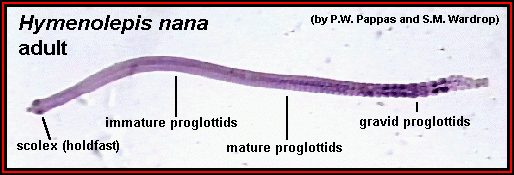Hymenolepis nana
Hymenolepis nana, the dwarf tapeworm, is the smallest tapeworm to infect humans. This cestode belongs to a large family known as Hymenolepididae.
The diagnostic features of this family are: scolex armed with one circlet of five hooks; one to three large testes and sacciform uterus. In addition to the H. nana, three other species, H. diminuta, H.microstoma and H.citelli have been used extensively for studies on cestodes.
Hymenolepis nana has a cosmopolitan distribution and is thought to be the most common tapeworm throughout the world. The infection is more frequently seen in children although adults are also infected, causing hymenolepiasis.
Life Cycle
The life cycle of H. nana does not require an intermediate host, complete development occurring within the villi of a single host, resulting in a ‘direct’ life cycle. It can also utilize an insect as an intermediate host.
The eggs that are released from mature proglottids in the upper ileum are usually passed out in the feces. If swallowed by another human they develop into hexacanth oncospheres and burrow into the villi of the small intestine. This is where they develop into tailless cysticercoids and then migrate towards the ileum and attach to commence the formation of proglottids.
The eggs which are ingested by insects, such as fleas, beetles or cockroaches hatch to form tailed cysticercoids which remain unmodified as long as they are inside the insect. If they are accidentally swallowed by a human they pass down to the ileum and establish themselves.
Morphology
H. nana egg is colourless, almost transparent, oval, 30–50 µm (micrometers) in diameter, has polar filaments. When shed in stool they are immediately infective and survive up to 10 days in the external environment, they are embryonated and have a 6-hooked oncospheres inside the shells. Shell consists of two distinct membranes. On inner membrane there are two small “knobs” or poles from which 4–8 filaments arise and spread out between the two membranes.
Adult form :
Scolex is small, 0.3 mm in diameter, globular (rounded), cup-like, situated at the anterior end, has four suckers and retractile rostellum with a single row of 20–30 hooks.
Gravid (mature, full of eggs) proglottids are 0.2–0.3 mm long and 0.8–0.9 mm wide.
Proglottid is filled with eggs, uterus is not visible.
Each proglottid has both male and female reproductive organs making Hymenolepis nana hermaphroditic. A proglottid copulates with itself or with other segments of the same individual or nearby Hymenolepis nana tapeworms. Proglottids usually disintegrate in the gastrointestinal tract and are rarely present in the feces.
Clinical Disease
Infections due to H. nana may cause no symptoms even with heavy worm burdens. However,symptoms of restlessness, irritability, anorexia, abdominal pain and diarrhea have beenreported. Heavy worm burdens may be caused by auto-infection which can be a problem in the immunocompromised.
Laboratory Diagnosis
The diagnosis is done by identifying tapeworm eggs in stool. Sometimes many stool specimens are needed to make the diagnosis. Hymenolepis nana starts laying eggs within a few weeks of the start of the infection and only after that it is possible to find eggs. Alternatively adult worm can be identified during endoscopic examination and rarely in stool samples .
treatment :
reference:
studyblue.com
DIAGNOSING MEDICAL PARASITES






